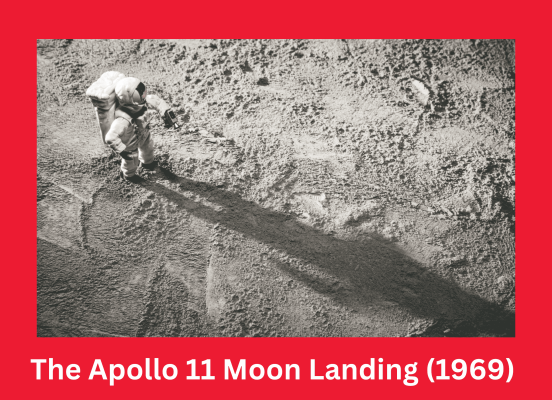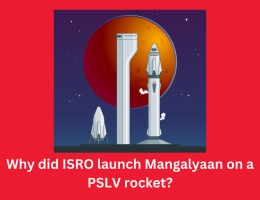
The Apollo 11 Moon Landing (1969) - Neil Armstrong and Buzz Aldrin became the first humans to set foot on the moon
- By admin --
- Tuesday, 12 Mar, 2024
The Apollo 11 Moon Landing of July 20, 1969, stands as an iconic moment in human history, marking the culmination of centuries of curiosity, scientific inquiry, and technological innovation. Led by NASA, the United States' space agency, the Apollo 11 mission achieved what was once thought impossible: landing two astronauts, Neil Armstrong and Buzz Aldrin, on the surface of the moon, while their colleague Michael Collins orbited above in the command module. This extraordinary feat not only captivated the world but also transformed our understanding of space exploration and the possibilities of human achievement.
The journey to the moon began with President John F. Kennedy's bold declaration in 1961 to put a man on the moon and return him safely to Earth before the end of the decade. At the time, the United States was locked in a heated space race with the Soviet Union, fueled by Cold War tensions and the desire for technological and ideological superiority. Kennedy's ambitious vision galvanized the nation's scientific community and spurred unprecedented investment in space exploration, leading to the development of the Apollo program.
After years of meticulous planning, testing, and preparation, Apollo 11 lifted off from Kennedy Space Center in Florida on July 16, 1969, atop a towering Saturn V rocket. Millions around the world watched in awe as the massive spacecraft soared into the sky, carrying the hopes and dreams of humanity into the vast unknown of space. The crew of Apollo 11 embarked on a journey of more than 384,000 kilometers (238,900 miles), navigating through the vacuum of space and braving the hazards of cosmic radiation and microgravity.
Four days after liftoff, on July 20, 1969, the lunar module Eagle separated from the command module Columbia and descended toward the lunar surface. With Neil Armstrong at the controls and Buzz Aldrin providing support, the lunar module executed a precise landing in the Sea of Tranquility, a flat expanse of the moon's surface. As the world held its breath, Armstrong's voice crackled through the radio: "The Eagle has landed."
Upon setting foot on the lunar surface, Neil Armstrong uttered his now-immortal words: "That's one small step for [a] man, one giant leap for mankind." With those words, Armstrong became the first human to walk on the moon, followed shortly by Buzz Aldrin. Together, they spent approximately two and a half hours exploring the lunar terrain, conducting scientific experiments, and collecting samples of moon rocks and soil.
While Armstrong and Aldrin made history on the surface, Michael Collins remained in orbit aboard the command module, conducting experiments and monitoring their progress. Collins' solitude in lunar orbit underscored the profound isolation and vulnerability of human beings in the vastness of space, serving as a poignant reminder of the risks inherent in space exploration.
The success of the Apollo 11 mission was a testament to the ingenuity, courage, and perseverance of the thousands of scientists, engineers, and technicians who contributed to its planning and execution. It was also a triumph of human collaboration and cooperation, transcending national boundaries and ideological differences in pursuit of a common goal.
The significance of the Apollo 11 moon landing extended far beyond its scientific and technical achievements. It captured the imagination of people around the world, inspiring a sense of wonder and possibility, and uniting humanity in a shared sense of awe and pride. The iconic images of the American flag planted on the lunar surface, the footprints left by the astronauts, and the Earthrise over the moon's horizon became enduring symbols of human exploration and achievement.
In addition, the Apollo 11 mission sparked developments in engineering, science, and technology that continue to this day. The missions which followed, Apollo 12, 14, 15, 16, and 17, referred back to those which preceded them, and also pointed to future moon settlements; the door was opened for them by it. They built on expertise that was acquired during previous ones in order to further understand and learn more about it. The knowledge obtained formed the basis upon which other approaches to investigate and settle the moon were founded due to the valuable details they provided in regard to its geology, air and likely assets.
The Apollo 11 landing on the moon has inspired scientists, explorers and engineers for generations to go beyond both human knowledge and good sense. It reminds us all that the human spirit and intelligence can triumph over seemingly impossible odds or obstacles. The footsteps of Neil Armstrong and Buzz Aldrin on the lunar surface serve as a timeless symbol of humanity's quest for exploration and discovery, reminding us that the sky is not the limit but rather the beginning of our journey into the cosmos as we gaze up at the stars and reflect on the mysteries of the universe.





